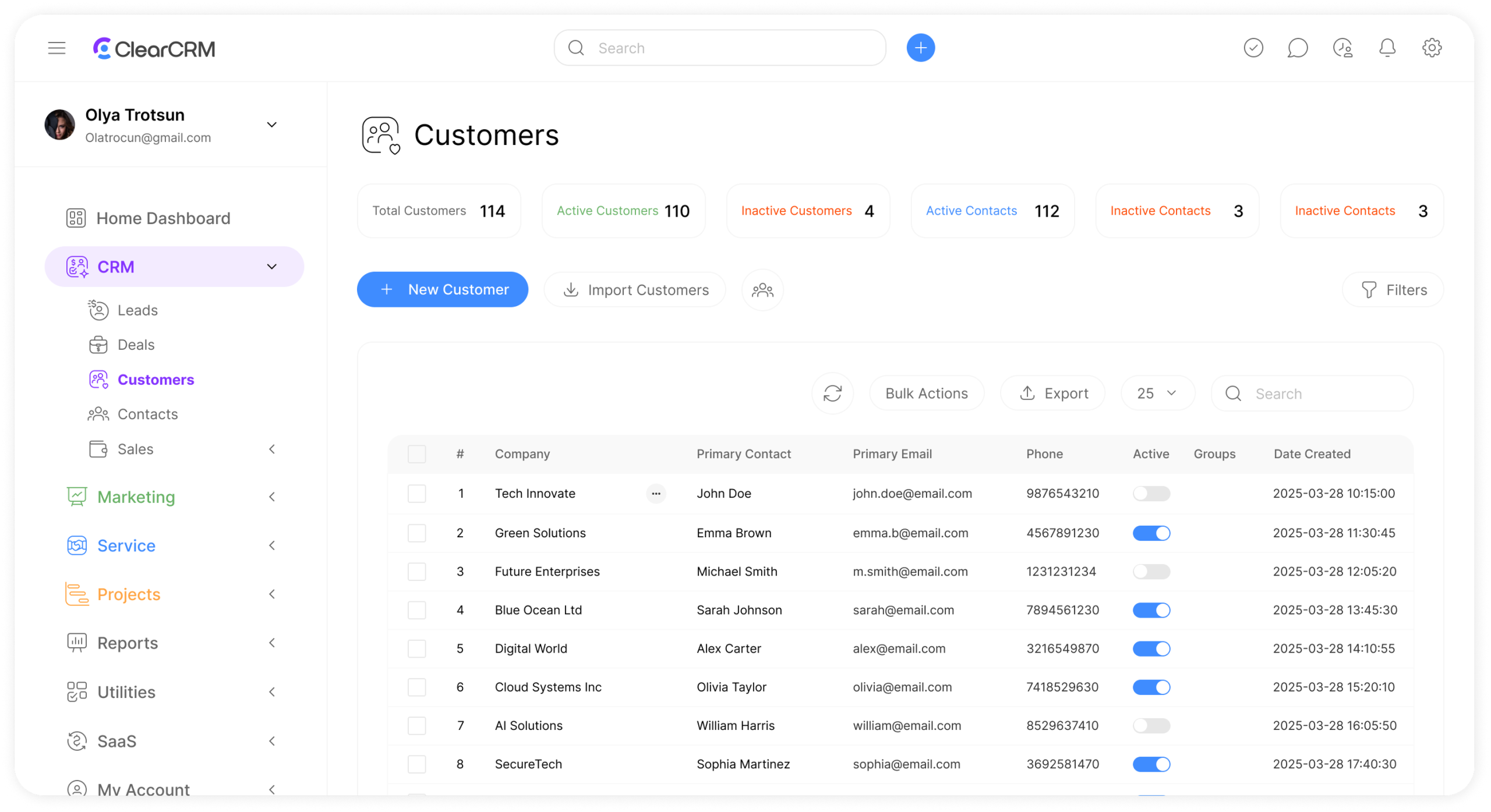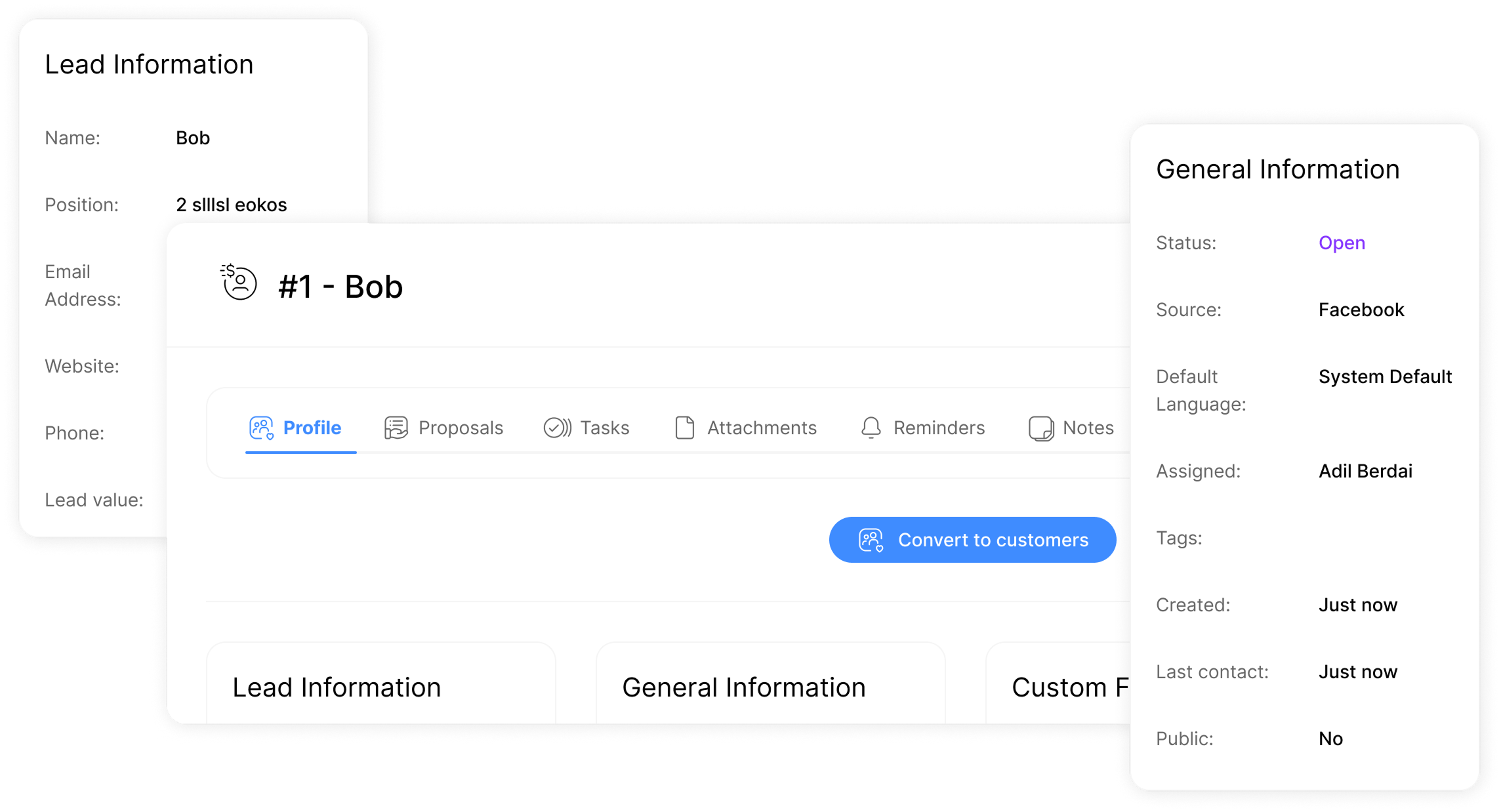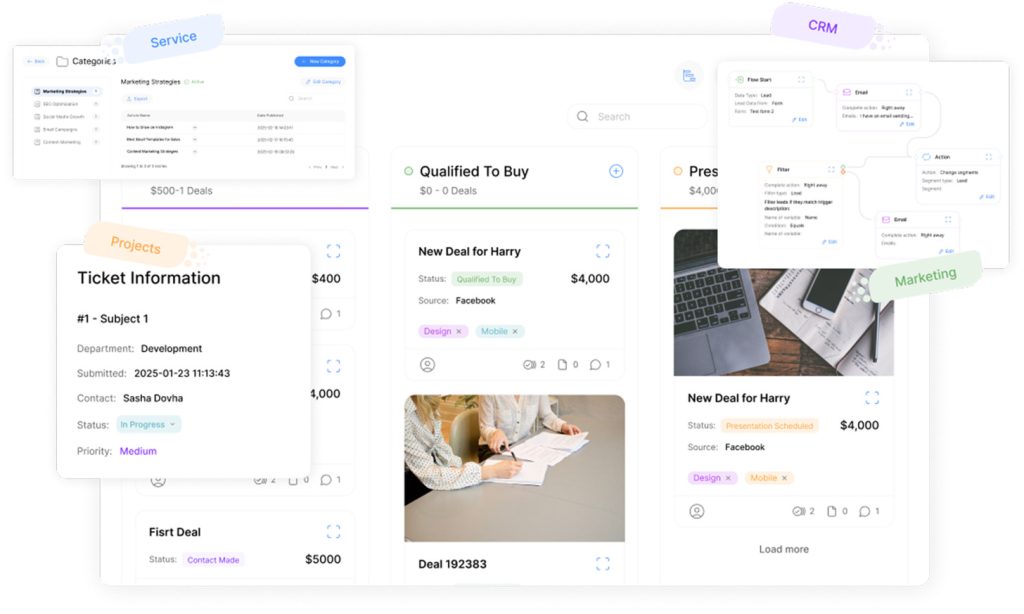The Ultimate Guide to Effective Customer and Contact Management


Build Complete Customer Profiles
Know your customers inside and out — all from one dashboard.
ClearCRM gives you a centralized hub for rich, actionable contact records.
- Store timelines, notes, and contact history
- Organize profiles by person or company
- Access everything with a single click
Convert Leads to Customers — Instantly
Turn interest into revenue without manual entry.
With one click, qualified leads become full customer records — ready for follow-up.
- Convert leads or even lost deals instantly
- Preserve data, notes, and linked tasks
- Skip the duplication and stay in flow


Stay Organized at Every Touchpoint
Track every relationship with full context.
Whether it’s a company or an individual, you’ll always see the full picture.
- Map contacts to companies automatically
- View linked deals, tasks, and communication
- Keep your team aligned with shared visibility
Efficient client information management is essential for modern businesses. Manual methods like spreadsheets often lead to fragmented data, missed opportunities, and strained relationships. Transitioning to digital solutions ensures teams can access accurate details instantly—whether tracking leads, resolving support tickets, or personalizing outreach.
Cloud-based systems eliminate the chaos of outdated processes. They centralize names, emails, and interactions in one secure database, reducing errors and saving time. Automated tools also recover lost details, ensuring no lead slips through the cracks. For example, integrating CRM systems streamlines workflows by merging contact management with sales pipelines and marketing campaigns.
Efficiency isn’t the only benefit. Teams using advanced software build stronger connections through tailored communication. Location data and purchase history help tailor messages that resonate with individual customers. This approach turns casual interactions into lasting partnerships.
This guide explores practical strategies to overcome common challenges. From selecting the right tools to optimizing data flows, it prepares professionals to transform how they handle critical information. The next sections dive deeper into implementation steps, ensuring businesses stay ahead in a competitive landscape.
Key Takeaways
- Cloud-based systems reduce errors and improve accessibility compared to manual spreadsheets.
- Automation recovers lost data and enhances sales and support efficiency.
- CRM integration centralizes information for seamless team collaboration.
- Personalized communication strengthens client relationships and loyalty.
- Adopting modern tools prepares businesses to tackle evolving operational demands.
Introduction to Customer and Contact Management

Manual tracking methods like paper notes or disorganized files drain productivity. Digital contact management systems solve this by storing names, emails, and interactions in a unified cloud-based database. This shift eliminates duplicate entries and ensures teams access accurate details instantly.
Understanding the Concept
Traditional approaches rely on error-prone spreadsheets or scattered documents. Modern software centralizes information, allowing real-time updates across departments. For example, sales teams track leads while support staff resolves tickets using the same centralized database.
| Features | Spreadsheets | Modern Systems |
|---|---|---|
| Data Accessibility | Limited to local files | Cloud-based, 24/7 access |
| Error Rates | High (manual entry) | Low (automated sync) |
| Collaboration | Version conflicts | Real-time updates |
The Importance for Modern Businesses
Outdated processes strain client relationships. A retail company using spreadsheets took hours to locate vendor details. After adopting a management system, they reduced search time by 70% and improved response accuracy.
Transition challenges include training teams and migrating legacy data. However, the long-term gains—like personalized marketing campaigns—outweigh initial hurdles. Clean, organized information fuels smarter decisions across sales, support, and operations.
Core Principles for Effective Contact Management
Efficiently managing contact data forms the backbone of modern operational workflows. Businesses that prioritize structured organization and real-time collaboration see measurable gains in productivity and decision-making. Below are the foundational strategies to maximize these advantages.
Organizing and Tracking Contact Details
Systematic organization minimizes time spent searching for phone numbers or email addresses. Automated tools capture details through web forms, email integrations, or business card scanners. These methods ensure data enters the database accurately without manual input.
For example, a logistics firm reduced entry errors by 45% after adopting automated tracking. Their system flags duplicate entries and updates job titles automatically when LinkedIn profiles change. This precision keeps sales pipelines moving smoothly.
| Features | Traditional Methods | Modern Software |
|---|---|---|
| Data Entry | Manual typing | Automated sync |
| Error Rates | 12-18% | <2% |
| Accessibility | Local storage only | Cloud-based access |
Centralizing Data for Team Collaboration
Centralized systems break down silos between departments. Marketing teams view client interaction histories, while support staff updates ticket statuses in real time. A shared software platform ensures everyone references the same information. This collaboration fosters a more cohesive approach to customer service, allowing for quicker resolution of issues and enhanced client satisfaction. By leveraging top rated customer support software, organizations can streamline their workflows and improve communication across teams. As a result, clients experience a seamless journey from initial contact through to resolution, strengthening their loyalty to the brand.
One healthcare provider cut meeting times by 30% after migrating to a unified system. Nurses, administrators, and billing specialists now access patient records simultaneously. Instant updates prevent miscommunication and delays.
Best practices include setting permissions for sensitive data and scheduling routine audits. These steps maintain consistency while empowering team members to work autonomously.
Benefits of Digital Contact Management Solutions

Modern teams achieve measurable efficiency gains through automated workflows. Digital tools eliminate time-consuming manual tasks while improving data accuracy—transforming how organizations handle critical interactions.
Streamlined Operations and Reduced Manual Efforts
Automation slashes hours spent on repetitive processes. For instance, web forms directly sync details like emails or job titles into centralized software, cutting data entry errors by 80%. A marketing agency reduced spreadsheet reliance and reclaimed 12 hours weekly for strategic work.
Integrated systems flag duplicates and outdated records automatically. This precision ensures sales pipelines stay current without manual audits. Teams focus on high-value tasks instead of cleanup.
| Manual Process | Automated Solution |
|---|---|
| 3-hour data entry per lead | Instant capture via CRM sync |
| 15% error rate | <2% discrepancies |
Enhancing Communication and Relationships
Centralized information enables hyper-personalized outreach. Support teams reference past purchases to resolve issues faster, while marketers segment audiences by location or engagement history.
One e-commerce brand boosted repeat sales by 34% using behavior-triggered emails. Real-time updates ensure messages align with recent interactions—whether a service inquiry or completed order.
Seamless CRM integration unifies communication channels. Sales reps access chat histories before calls, fostering context-rich conversations that build trust and loyalty.
Best Practices for Managing Customer and Contact Data
Consistent frameworks separate thriving organizations from those struggling with chaotic workflows. Implementing standardized protocols ensures teams collect, store, and use information effectively while meeting legal obligations.
Establishing Uniform Data Collection Standards
Centralized templates eliminate inconsistencies across departments. For example, marketing and sales teams using identical web forms capture names, job titles, and preferences uniformly. Automated validation checks flag missing fields or formatting errors before data enters the system.
A SaaS company reduced duplicate entries by 60% after adopting standardized forms. Regular audits further ensure records stay current. Training programs teach staff to update profiles during calls or meetings, maintaining accuracy without extra hours.
Ensuring Security, Compliance, and Data Integrity
GDPR and CCPA require encrypted storage and strict access controls. Role-based permissions limit who views sensitive details, while audit logs track changes. Multi-factor authentication adds another layer against breaches.
“Data protection isn’t optional—it’s foundational to maintaining trust in digital operations,” notes a cybersecurity advisor at TechShield Solutions.
One financial firm avoided $2M in potential fines by automating compliance reports. Scheduled backups and version histories also safeguard against data loss. These measures build client confidence while aligning with evolving regulatory frameworks.
Leveraging Contact Management for Sales and Marketing Success

Tailored messaging drives modern sales success. Integrated contact management systems enable businesses to craft campaigns that resonate with specific audiences. By combining behavioral insights with demographic data, teams deliver relevant content at optimal times. These targeted approaches are further enhanced by robust customer profile management strategies, which allow teams to segment their audience effectively. By understanding the unique preferences and pain points of different customer segments, businesses can personalize their outreach even further. Ultimately, this level of personalization fosters stronger customer relationships and drives higher conversion rates. Furthermore, leveraging data analytics can enhance these customer management strategies for businesses, allowing for continuous refinement of engagement tactics. As businesses stay attuned to changing consumer trends, they can adapt their messaging to remain relevant and impactful. This proactive approach not only boosts brand loyalty but also positions organizations to capitalize on emerging market opportunities.
Precision Targeting Through Segmentation
Audience segmentation divides prospects into groups based on shared traits. Criteria like purchase history, geographic location, or engagement frequency help tailor outreach. For example, an e-commerce brand boosted conversions by 27% by sending abandoned cart reminders to high-intent shoppers.
- Behavior-based campaigns: Trigger emails when users browse specific product categories.
- Demographic filters: Customize offers for students versus corporate clients.
- Engagement tiers: Prioritize leads who open emails or click links repeatedly.
Automated software simplifies this process. Tools tag contacts dynamically as they interact with websites or campaigns. Sales teams then access real-time lists of warm leads ready for follow-up. These leads can be prioritized based on their engagement levels, allowing sales teams to focus their efforts where they are most likely to succeed. Furthermore, integrating onceclick conversion strategies can significantly enhance the effectiveness of these efforts, streamlining the transition from interest to acquisition. As a result, businesses can improve their conversion rates and drive revenue growth more efficiently. These innovative tools not only streamline lead management but also enhance the overall efficiency of the sales process. By utilizing oneclick strategies for lead conversion, sales teams can quickly deploy tailored outreach efforts, significantly increasing their chances of closing deals. As a result, businesses can experience accelerated growth and a more engaged customer base.
| Basic Segmentation | Advanced Segmentation |
|---|---|
| Location, job title | Purchase frequency + browsing patterns |
| Email engagement | CRM integration + predictive analytics |
Collaboration amplifies results. Marketing shares campaign metrics with sales through shared dashboards. This alignment ensures follow-ups reference recent interactions—like webinar attendance or content downloads.
“Granular segmentation turns generic blasts into conversations that convert,” explains a growth strategist at RevGenius.
Practical implementation steps include auditing existing data for gaps and training teams to update profiles consistently. Platforms like HubSpot or Salesforce offer built-in tools to automate these workflows at scale.
Integrating Contact Management with CRM Systems
Bridging standalone tools with comprehensive platforms unlocks deeper operational insights. Unlike basic tools that only store names and emails, CRMs analyze customer interactions to predict needs and automate workflows—adding strategic value to daily operations. This synergy transforms how teams convert leads into loyal clients.
Comparing Contact Management Tools and CRM Features
Simple tools excel at organizing contact details like phone numbers or job titles. CRMs add layers of functionality—tracking deal stages, forecasting revenue, and generating performance reports. For instance, Zendesk’s basic plan manages tickets, while its CRM suite maps customer journeys across channels.
| Capability | Contact Tools | CRMs |
|---|---|---|
| Interaction History | Basic notes | Timeline with sentiment analysis |
| Automation | Email reminders | Workflow triggers + AI recommendations |
| Reporting | Exportable lists | Custom dashboards + ROI tracking |
Marketing teams using HubSpot’s free tools handle email campaigns. Upgrading to its CRM reveals which content drives conversions—a gap standalone systems can’t fill.
Strategies for Seamless Data Integration
APIs sync existing software with CRMs without manual entry. A logistics company automated lead imports from web forms into Salesforce, cutting onboarding time by 50%. Data mapping aligns fields like “company size” across platforms to prevent mismatches.
- Use middleware like Zapier for non-technical teams
- Schedule weekly audits to flag duplicates
- Train staff to update both systems simultaneously
“Integration isn’t just technical—it’s cultural. Teams must embrace shared workflows to maximize ROI,” advises a HubSpot solutions architect.
Platforms like ClearCRM merge contact histories with sales pipelines, ensuring context-rich client engagements. Real-time sync eliminates version conflicts, letting support and sales collaborate on resolving issues faster.
Common Challenges and Solutions in Customer and Contact Management

Fragmented data storage creates bottlenecks across departments. Teams waste hours reconciling spreadsheets or chasing outdated records. These hurdles often stem from manual processes and disconnected tools.
Overcoming Data Silos and Inconsistencies
Operational silos emerge when sales uses one system while support relies on another. A logistics company discovered warehouse teams couldn’t access updated client addresses, delaying 15% of shipments. Centralized software resolved this by merging databases into a single source.
| Challenge | Solution |
|---|---|
| Duplicate entries | Automated deduplication tools |
| Version conflicts | Real-time cloud sync |
| Access restrictions | Role-based permissions |
Standardized protocols prevent inconsistencies. Requiring uniform field formats—like phone numbers or job titles—ensures cleaner information. Regular audits further maintain accuracy.
Automating Processes to Save Time and Reduce Errors
Manual entry errors cost businesses 6% of annual revenue on average. Automating tasks like lead capture or follow-up reminders cuts this risk. One firm reduced data entry time by 80% using web form integrations.
- Template-based workflows: Auto-assign tasks when leads reach specific stages
- AI validation: Flag missing fields during form submissions
- Scheduled syncs: Update records across platforms hourly
“Automation isn’t about replacing people—it’s about amplifying their impact,” states a operations director at FlowTech Analytics.
Practical implementation starts with identifying repetitive tasks. Migrating these to contact management tools frees teams for strategic work while ensuring error-free operations.
Future Trends and Innovations in Contact Management
The next wave of innovation in organizational tools is driven by AI and automation. These advancements promise to transform how teams capture, analyze, and act on critical information. From predictive analytics to self-updating databases, emerging technologies eliminate friction in daily workflows.
Intelligent Systems Redefining Efficiency
Machine learning algorithms now forecast client needs by analyzing past interactions. For example, platforms like Salesforce Einstein GPT suggest follow-up actions based on email sentiment or meeting notes. This reduces guesswork and lets teams prioritize high-impact tasks.
Automation extends beyond data entry. Voice-to-text tools transcribe calls instantly, while AI-powered scanners extract details from business cards with 99% accuracy. One logistics firm cut onboarding time by 40% using these integrations.
| Current CRM Features | Future Capabilities |
|---|---|
| Basic interaction logs | Predictive behavior modeling |
| Manual data cleanup | Self-healing databases |
| Static reports | Real-time ROI simulations |
“Systems will soon anticipate needs before users recognize them,” predicts a lead developer at TechShield Solutions. “This shifts contact management from reactive to proactive.” This evolution in contact management will enable businesses to provide tailored interactions, enhancing customer satisfaction and engagement. As a result, companies will need to invest in advanced contact center solutions and strategies that leverage artificial intelligence and data analytics to stay ahead of customer expectations. Such proactive approaches are essential in fostering long-term relationships with clients in an increasingly competitive landscape.
Businesses preparing for these shifts should audit their tech stacks for AI readiness. Prioritize platforms with open APIs for seamless upgrades. Training programs focused on data hygiene ensure teams maximize new tools from day one.
Continuous innovation remains vital. Early adopters of blockchain-based verification or IoT-driven systems gain competitive edges through faster, more secure operations. The future belongs to those who view software not as tools, but as strategic partners.
Conclusion
Adopting modern solutions transforms how businesses operate daily. Centralized contact management systems eliminate scattered data while automation reduces manual tasks. Teams collaborate seamlessly through shared platforms, ensuring everyone accesses updated information instantly.
Integrating basic tools with advanced CRMs unlocks deeper insights. Sales pipelines gain precision through behavioral tracking, while marketing campaigns achieve higher engagement via segmentation. These strategies turn fragmented processes into cohesive workflows.
Decision-makers should prioritize adopting streamlined software. Start by auditing current systems and migrating to cloud-based platforms. Training team members ensures smooth transitions and maximizes ROI from new tools.
The future lies in AI-driven innovations that predict needs before they arise. Businesses embracing continuous improvement will lead their industries. Now is the time to act—streamline your contact workflows, empower your team, and turn scattered data into a strategic growth engine.

